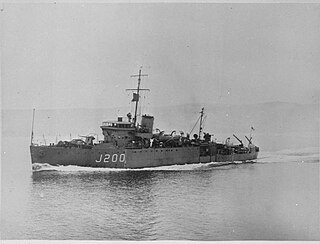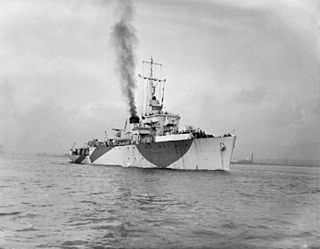
Arromanches (R95) was an aircraft carrier of the French Navy, which served from 1946 to 1974. She was previously HMS Colossus (15) of the Royal Navy. She was the name-ship of the Colossus class of light carriers. She was commissioned in 1944, but did not see any action in World War II. She served with the British Pacific Fleet in 1945–46, as an aircraft transport and repatriation ship.

HMS Pelorus was an Algerine-class minesweeper built for the Royal Navy (RN) during World War II. Upon completion, the ship became the flotilla leader of the 7th Minesweeper Flotilla, clearing mines off the east coast of England. In June 1944, the flotilla was assigned to sweep one of the beaches during the Normandy landings until she struck a mine the following month. After her repairs were completed, Pelorus was reassigned to the English Channel and the 6th Minesweeping Flotilla. The flotilla was transferred to the Indian Ocean in 1945 and spent some time escorting convoys. They participated in Operation Collie, a bombardment of Japanese positions in the Nicobar Islands, in July and then swept the Strait of Malacca and the approaches to Singapore in August.

HMS Rotherham was an R-class destroyer of the British Royal Navy during the Second World War, named after Captain Edward Rotheram, who commanded HMS Royal Sovereign during at the Battle of Trafalgar in 1805. Rotherham was completed in 1942 and equipped as a flotilla leader, having slightly reduced armament to allow for the increased complement and working space required. Decommissioned in 1945, the ship was sold to India in 1948, serving as INS Rajput (D141) until 1976, when she was scrapped.

HMS Rifleman was a turbine-powered Algerine-class minesweeper of the Royal Navy. She was launched in 1943 and saw active service during World War II, both in the European and Far East theatres. After the war she served in the Mediterranean and was used as an accommodation ship in Barrow before being sold for breaking in 1972.

HMS Adventure, pennant number M23, was an Adventure-class minelaying cruiser of the Royal Navy built in the 1920s that saw service during the Second World War. Her commander between 1928 and 1929 was the future First Sea Lord John H. D. Cunningham. Laid down at Devonport in November 1922 and launched in June 1924, Adventure was the first vessel built for service as a minelayer; she was also the first warship to use diesel engines, which were used for cruising. Adventure first joined the Atlantic Fleet, then was transferred to the China Station in 1935. In World War II, the ship was damaged in 1941 and 1944, and was converted to a landing craft repair in 1944. In 1945 Adventure was reduced to reserve and in 1947 she was sold and broken up for scrap.

HMS Ulster was a U-class destroyer of the Royal Navy of the United Kingdom that saw service during World War II. She was later converted into a Type 15 fast anti-submarine frigate, with the new pennant number F83. Ulster was the second vessel in Royal Navy history to have that name.

HMS Albury was a Hunt-class minesweeper of the Aberdare sub-class built for the Royal Navy during World War I. She was not finished in time to participate in the First World War and survived the Second World War to be sold for scrap in 1947.
HMCyS Vijaya, named in honor of Vijaya, the first king of Sri Lanka, was an Algerine-class minesweeper of the Royal Ceylon Navy, the first warship of that navy. Vijaya had been built as HMS Flying Fish (J370) for the Royal Navy during World War II, but was given to Ceylon by the United Kingdom upon the 1951 formation of Ceylon's navy.

HMS Artifex was a repair ship of the Royal Navy from late in the Second World War and into the Cold War. Launched as the Cunard liner RMS Aurania she was requisitioned on the outbreak of war to serve as an armed merchant cruiser. Damaged by a U-boat while sailing with an Atlantic convoy, she was purchased outright and converted to a floating workshop, spending the rest of her life as a support ship for the navy.
HMIS Kathiawar (J155) was a Bangor-class minesweeper built for the Royal Navy, but transferred to the Royal Indian Navy (RIN) during the Second World War.
HMIS Baluchistan (J182) was a Bangor-class minesweeper built for the Royal Navy, but transferred to the Royal Indian Navy (RIN) during the Second World War.
HMIS Khyber (J190) was a Bangor-class minesweeper built for the Royal Navy, but transferred to the Royal Indian Navy (RIN) during the Second World War.
HMIS Kumaon (J182) was a Bangor-class minesweeper built for the Royal Navy, but transferred to the Royal Indian Navy (RIN) during the Second World War.
HMIS Carnatic (J182) was a Bangor-class minesweeper built for the Royal Navy, but transferred to the Royal Indian Navy (RIN) during the Second World War.
HMIS Rajputana (J197) was a Bangor-class minesweepers built for the Royal Navy, but transferred to the Royal Indian Navy (RIN) during the Second World War.

HMIS Orissa (J200) was a Bangor-class minesweepers built for the Royal Navy, but transferred to the Royal Indian Navy (RIN) during the Second World War.
HMIS Konkan (J228) was a Bangor-class minesweepers built for the Royal Navy, but transferred to the Royal Indian Navy (RIN) during the Second World War.

HMS Squirrel was a turbine-powered Algerine-class minesweeper built for the Royal Navy during the Second World War. She was scuttled after striking a mine in 1945.

HMS Vestal was a turbine-powered Algerine-class minesweeper of the Royal Navy. She was launched in 1943 and saw service in the Pacific War against the Empire of Japan. She was critically damaged by Japanese kamikaze aircraft in 1945 and was subsequently scuttled in waters close to Thailand.

HMS Cyclops (F31) was a submarine repair and depot ship of the Royal Navy. She was originally the passenger liner Indrabarah sister ship to Indralema, built by Laing, for the Indra Line Ltd then bought by The Admiralty, while she was building. She was launched on 27 October 1905.












